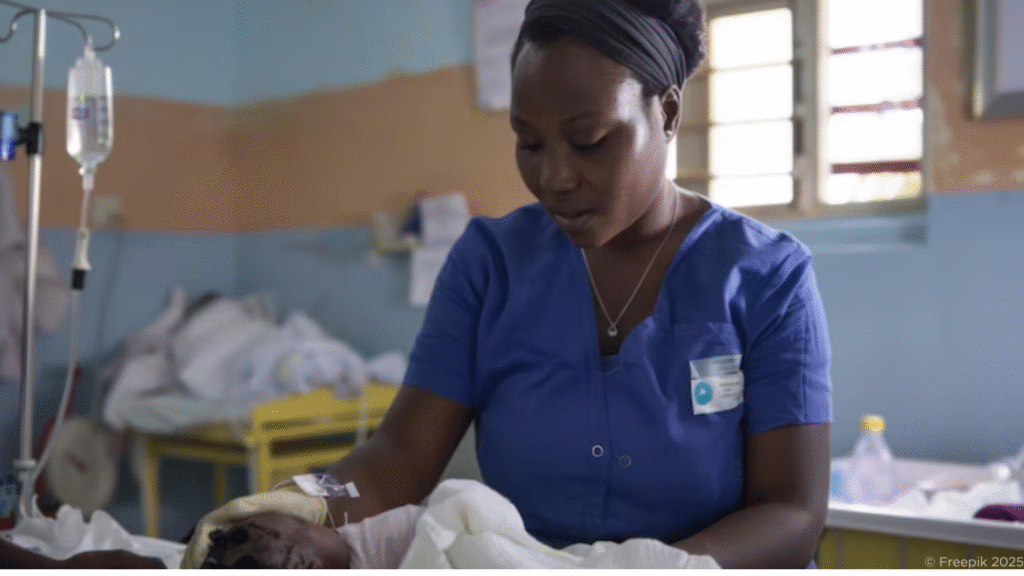
How does it feel to work in a hot room where the air barely moves, your clothes stick to your skin because of sweat, and your concentration drops with each passing hour?
As climate change intensifies, health facilities that were not designed for extreme temperatures are struggling to keep health workers safe and patients comfortable. What does this mean for health workers who keep our health facilities running? And how prepared are health systems to protect them as the world grows warmer?
These questions are at the heart of the HIGH Horizons study, which explores how rising temperatures affect health workers and the quality of care they provide. This blog reflects on research insights from study sites in South Africa and Zimbabwe: what we are learning, and why it matters for the future of health services and health care in a changing climate.
Why this matters
Healthcare workers are the foundation of every health system. Yet in many health facilities across sub-Saharan Africa, including in maternity and newborn wards, temperatures regularly rise above safe limits.
With rising temperatures, health workers are increasingly exposed to extreme indoor heat due to climate change, poor facility design, and inadequate adaptation infrastructure. These conditions threaten both their wellbeing and the quality of care they provide.
Continuous exposure to extreme heat affects how people think, move, and interact. Heat induces stress, and when the body is under stress, attention slips, patience shortens, and small errors become more likely. For health workers in labour wards or emergency rooms, this can mean choosing between comfort and focus, between staying hydrated and staying at their post, all of which put their wellbeing at risk.
The HIGH Horizons study: methods
As part of the HIGH Horizons project, research is ongoing in South Africa and Zimbabwe to understand how heat exposure affects health workers and the quality of care they provide.
The research combines a longitudinal health-worker survey tracking wellbeing, stress, anxiety and hydration levels using urine-specific gravity tests, continuous indoor temperature monitoring, and a time–motion analysis linking care quality to heat exposure.
In South Africa and Zimbabwe, these findings are complemented by ethnographic observations and in-depth interviews with health workers and facility managers. Together, these methods helped to capture what happens under heat stress as well as how workers adapt in real time.
Emerging findings
The findings show that indoor temperatures especially in maternity and neonatal wards frequently exceeded 30°C, sometimes remaining higher than outdoor readings for several hours. In Zimbabwe, 75% of health workers were dehydrated during the hot season, and more than half in South Africa showed similar signs.
Statistical analyses showed that each 1°C increase in thermal stress measured as Wet Bulb Globe Temperature (WBGT) linked to a small but meaningful decline in wellbeing scores and higher levels of perceived stress. Observations also indicated that under extreme heat, health workers were less likely to perform certain aspects of respectful care such as maintaining continuous companionship for women in labour.
Additionally, qualitative findings provided important context. Health workers described tiredness, dizziness, and difficulty concentrating, often accompanied by skin problems, irritability, dehydration and cognitive slowing. Many highlighted the strain of staying alert and empathetic while physically uncomfortable. Extreme heat often altered workflows, and staff prioritised urgent clinical tasks while reducing patient communication and respectful care. They also reported coping through improvisation; using wet towels, rotating tasks, scheduling work during cooler hours, and forming “water-buddy” systems. These improvisations were practical but temporary because they lacked formal institutional support.
The bigger picture: implications
The study highlights that heat is already a significant occupational health risk in health facilities. It is no longer a distant concern but a daily challenge for those in the frontlines of health services, especially in sub-saharan Africa.
When we think about strengthening health systems, we often refer to equipment, supplies, and staffing. But how often do we consider the temperature of the spaces where people work? Or how the midwife’s ability to provide calm, respectful care can depend on whether he or she is dehydrated or struggling to stay focused in a 32°C ward?
Adapting to rising temperatures requires changes spanning infrastructure, workplace policy and training. Health facilities need better ventilation, shading, and access to water. At the same time, workplace policies can include regular hydration breaks, flexible scheduling during heatwaves, and training on how to recognize and manage heat stress.
These are practical and affordable adaptation measures but they require awareness and political will. Investing in heat-resilient health systems is vital for safeguarding health workers in a warming world.
Reflections
One thing that stood out during the study was how normalized discomfort had become. Health workers rarely complained; they simply adapted and carried on. But what does it say about our health systems when enduring discomfort is seen as part of the job? Endurance is admirable, but it should not be the foundation of workplace safety. Hence, we cannot continue asking health workers to cope individually with what is, at its core, a structural, policy and systems problem.
As new health facilities are built and old ones renovated, climate resilience must be part of the design. Ventilation, cooling, reliable water, and heat protection are essential for safe and high-quality healthcare delivery. Therefore, If we want to strengthen health systems for the future, we have to start with the people who are core to their success – health workers.
Adaptation and mitigation strategies, targeted investments, and stronger heat–health policies will all be essential for protecting healthcare workers. At HIGH Horizons we are promoting the integration of climate adaptation and mitigation into maternal, newborn, and child health services & strengthening health system resilience. We are also implementing and evaluating several heat-health interventions in South Africa and Zimbabwe, stay tuned…
Follow us on LinkedIn at HIGHHorizons and visit our blog at highhorizons.eu to learn more about our work & stay updated
